Test report digital camera software SilverFast DCPro
Those who want to get the best possible image quality from their digital camera will not be able to avoid using the RAW format. The later optimization of these raw data at the computer enables a considerable improvement of the image results in comparison to the automatic interpretation by the internal image processing algorithms of the camera.
SilverFast DCPro is not available any more.
If the photography should reproduce the colour exactly, the profiling of the camera is required. A digital camera can be calibrated and profiled as it is also the case in a scanner, a monitor or a printer.
With SilverFast DCPro, LaserSoft Imaging provides the photographer with a tool that unites both aspects in a programe. Therewith, the raw data of the camera can be processed and optimized and also individual camera profiles can be issued in the comfortable way that is so typical for SilverFast.
What does the software SilverFast DCPro do?
SilverFast DCPro is a software for processing the raw image data. These so-called raw data are the image data of the digital camera the way they are captured by its sensor - they are not interpolated to a finished image, neither any corrections are made the way it is usually automatically done by the internal image processing of the camera in order to get a "real" image. With SilverFast DCPro, also those raw scans made with the scan software SilverFast Ai can be processed. In order to generate such a raw scan, one adjusts during the scanning the output type "48 Bit HDR colour" and/or "16 Bit HDR grey scales". More information is obtainable in our SilverFast HDR test report.
Moreover, it is possible to adjust some individual camera profiles with SilverFast DCPro. By photographing the supplied calibration target and the later evaluation of the photography by the software, SilverFast DCPro calculates an ICC-profile that compensates the "tritanopia" of the camera in use. By this way, the biggest possible colour fidelity can be achieved. Therewith, DCPro does what the scan software SilverFast does with the scanners with the help of an IT-8 target that is measuring their error and correct it. With such a profiling process, those input devices as scanners and digital cameras deliver some real and colourfast images.
SilverFast DCPro looks like the scan software SilverFast and is also handled like it. By opening a raw data file with this programe, one sees the image immediately in the way it would look like with the adjustments during the photographing. Now it is possible to modify all of these image adjustments. Everything what one normally would have adjusted before photographing can be done later on. Once the desired result is achieved, one does only need to click on the processing-button of the normal scan software of SilverFast, type in the file name and one gets the finished image file.
What does raw-format mean and which advantages does it offer?
The raw-format is a file format of digital cameras that contains the lossless and unmodified data captured by the image sensor. The raw file does not contain all the colour information of a finished image file in the JPG- or TIF-format, as these have to be laboriously computed first. Parameters as the white balance, contrast, sharpness, colour saturation and image noise reduction do not have to be considered during the photographing in the raw-format. Contrary to the exposition time, aperture and ISO-sensitiveness, these parametres do not depend on the hardware.
Thus, by using the raw format, one does not leave the adjustment of those values to the internal processing algorithms of the camera but one can specificly accomplish them on the computer and adapt them optimally to the desired result. Thereby, depending on the used raw-converter, one gets much more comprehensive and precise possibilities of adjustment. Thereby, a considerable increase of the image quality is possible to together with the increased dynamic range of the image information contained in the raw format.
And of course, by using the raw format, one has later the possibility to find the optimal adjustments. Those who do not know whether they have to adjust "flashlight", "artificial light" or "automatic" as white balance while photographing an object in the interior of the room with the flash activated, can comfortably test all these adjustments in the raw-converter one by one and by this way find the optimal adjustment. Thus, in the case of raw photographies, the definite camera adjustments are not made during the photographing but later on during the raw-conversion.
Why should a digital camera be profiled?
There is no camera that straight represents the colours the way they look in reality. Thereby, the colour errors do not only differ from producer to producer, neither only from model to model but even two cameras of the same model can differ due to some fluctuation in the production. This effect appears everywhere in the technique: by buying 5 scales of the same type, every one will indicate a different weight.
By using an individual camera profile, these deviations can be corrected without processing the images later. Thereby, the individual camera is measured first in order to determine its colour deviations and to save a so-called camera profile. Thus, such a camera profile contains the colour errors of the camera saved in a compact format. Then, during the raw conversion, the camera profile is used in the automatic error correction. Thereby, one does not only save time and probably also money, but also increases the image quality, as from the very beginning, the colours are correct.
Thus, when it comes to the exact colour reproduction, as for example in case of art reproductions or product photographies, one sholud basically use camera profiles. But also every amateur photographer gets some better digital images by measuring his camera, photographing in the raw format and processing them automatcally.
Different versions of SilverFast DC
First, I will tell a few words about the different available versions of SilverFast DC. Currently, there are six versions available (03/2008):
- SilverFast DC SE 6.5
Standard version for beginners without any additional features
- SilverFast DC VLT 6.5
with some additional functions for the colour management, batch mode and printing
- SilverFast DCPro 6.5
Pro-Version with the full range of functions including calibration target for the camera profiling
- SilverFast DCPro Studio 6.5
Studio-Version with additional features including calibration target for the camera profiling
- SilverFast DCPro Studio PhotoProof
Studio-Version with additional features including calibration target and PhotoProof Plug-In
- SilverFast DCPro Studio ColorServer
Studio-Version with additional features including calibration target and ColorServer Automation-Tool
Compared to SilverFast DC SE, SilverFast DC VLT offers some additional functions for the colour management and the batch mode. Moreover, it also contains the print-tool PrinTao. The DCPro-version contains, beside some further additional features, the possibility to generate an individual camera profile with the help of the provided calibration target.
Compared to SilverFast DCPro, SilverFast DCPro Studio contains more additional features as the automatic colour optimation AACO, the support of the JPEG 2000 format, the enhanced usharp masking USMPlus, the stamp tool CloneTool, and the PrinTao module enhanced in the text ad layout functions.
The additional option PhotoProof enhances SilverFast DCPro Studio by a proof-function, with which one can arrange a softproof and also edit some legal proof-printouts with an attached FOGRA-medium wedge on a calibrated and linearized output device with the support of PrinTao.
ColorServer is an automation tool with which one can automate the workflows of large amounts of images. By this way, it is possible to accomplish gradiation- and tonal value corrections, colour space conversions and all other possible image adjustments of SilverFast DCPro Studio automatically in a cofortable way.
Soft-Proofing with PhotoProof
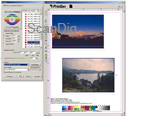
The CMYK separation, thus the processing of the RGB-data to printable CMYK-data is normally a laborius matter. PhotoProof can simplify this process. With only a few mouse clicks, it enables the user to arrange a softproof, so that the output colour space is simulated on the screen.
On a linearized and calibrated output device assisted by PrinTao a proof print of the picture in the output color range can be made. The integration of a FOGRA medium wedge (different medium wedges for different measuring instruments are provided) secures the legally binding effect of the proofs - provided the evaluation of the printed medium wedge, which requires additional hard- and software, shows the deviations are within the given tolerances.
Automation and batch processing with the ColorServer
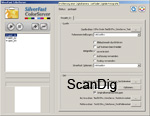
The automation tool ColorServer makes the batch processing of image files possible. The program works with so-called Hotfolders. Those are folders, which are constantly supervised by the current program. If a new file is being saved in a Hotfolder, this file is being processed according to the adjustments - all adjustments possible in SilverFast DC Pro are available.
The processed file is then stored in the before chosen target folder and the original is being shifted from the Hotfolder into the likewise before chosen archive folder. Furthermore, an error folder can be determined in which all files will be stored where during the processing an error arose.
Thus, in practice, one arranges a Hotfolder and any time one wants to process some images with the desired adjustments one simply moves them into the respective data file and everything runs automatically. It couldn't be easier!
DC-practice: Processing raw data with SilverFast DCPro
Many different workflows can be realized with SilverFast DCPro. We want to show you in the following chapters how to work in general with SilverFast DCPro the available Add-Ons, and describe the appropriate proceedings.
First we will describe the work routine and how one processes raw scans with SilverFast DCPro:
Step 1: Creating RAW-data
The photographed pictures have to be saved in RAW-format in the storage medium of the camera. Then, the image adjustments as the white balance and sharping are secondary - they are optimized later on. After photographing it is recommendable to transfer the data to the hard disk of the computer. The raw data should be archived separatedely, also after the computation of the finished image file.
Step 2: Image optimization and computation of the finished image file with DCPro
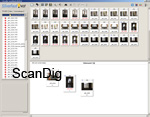
Now the data can be processed wirh SilverFast DCPro. Through the so-called VLT (virtual light table) the pictures for the processing can be selected, viewed and organized. The VLT is divided into three areas: folder tree structure, preview area with thumbnails of the pictures of the current file and a "light table", on which one can position thumbnails of the pictures freely. A doubleclick on a picture, which is on the light table or within the thumbnails, opens the SilverFast main program. All adjustments which can be made with the SilverFast scanning software prior to the scan, can be done now afterwards.
All possibilities of adjustent of SilverFast Ai as for example the gradiation curves, tonal values, colours and sharpening are also available here. In the separated window for the image adjustment there are, beside the options exposition, white balance, brightness and contrast, some further specific camera-Raw adjustments available: There is a choice of white balance-presets, a magenta-green-colour control, a control for the luminance smoothing and another control for the reduction of the image noise.
As soon as the result is satisfactory, the finished image file can be computed: one simple click on the "process" button is enough, and after entering the desired file name and the destination folder the picture is made. This works very fast: after a few seconds - depending on the computer speed - an image of 10 megapixels is finished and saved.
DC-practice: Profiling a digital camera
With the help of the provided calibration target and the function for the profile creation that is integrated in the software, the SilverFast DCPro enables a simple and comfortable optimization of a digital camera.
Step 1: Photographing the calibration target
First, the calibration target must be photographed. Thereby it is important to avoid the reflections on the surface and ensure an even illumination. The best is to accomplish this in a photo studio with at least two diffusing lamps each possitioned at the right and at the left at an angle of 45° to the target.
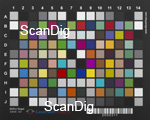
What is also very important to pay attention to the right exposition. The most exact measurement is achieved with an exposure meter and the light measuring. Then the light is measured in all four corners and in the centre of the target and the lamps are adjusted in a way that in all measuring points show the same exposure values. If one does not have the respective equipment, it is also possible to accomplish an incident and reflected light measuring on a greycard with the exposure meter that is integrated in the camera. If there is also no greycard available, the target can be also measured and an exposure series made. Then one chooses the photography where the white point shows some RGB values of approximately 240. This can be measured, for example, with the densitometer of SilverFast.
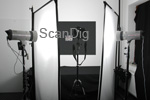
The correct white balance is another crucial element for generating an error-free profile. In case of the most cameras, a neutral grey surface is to be measured. Therefore, a greycard is the most suitable item that is illuminated with the light with which later on the calibration target also will be photographed.
In the adjacent image, the studio setup is shown that we have arranged for photographing of the testchart. Therewith, the conditions were optimal. But the right photographing of the target is not only possible in the photo studio. It is also possible to photograph it in the open air if the reflections can be avoided. Of course, it has to be also paid attention to the correct white balance and the right exposure.
Step 2: Evaluation of the target and computation of the profile
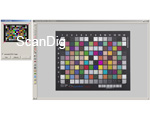
Once the target is photogrpahed, the respective RAW-file can be opened in SilverFast DCPro. Therefore one clicks on the calibraton button whereby one has to determine first, by setting a check mark, that instead of an IT-8 target the special DCPro target will be used. Now, with the help on a squared and dotted frame which corner points can be moved independently of each other,one determines the edges of the target. Within this frame, the position marks for the colour fields are available that, with the correct alignment, are located exactly over the colour fields.
By clicking on start, SilverFast recognizes through the bar code on the target which reference file belongs to the original material in use, and computes the profile with it. Now, a name can be assigned to the profile and the respective index is saved and automatically activated respectively. From now on, for every file opened in SilverFast DCPro, this profile is considered as long as one does not deactivate it or as long as no other profile is chosen.
Step 3: Selection of the respective profile
It does make sense to generate some individual profiles for different lighting situations. But normally, 2-3 profiles for the photographic practice are sufficient. By this way, it is possible to create a profile with flash light that can be also used for daylight shots without any problem as long as the white balance is respectively adapted. Now, another profile for the bulb light and, for example, another one for the halogen light can be set. With this, one is well prepared for most of the situations and only for very special lighting conditions one would need other profiles. The profile that should be considered during the computation of the finished image file can be selected in the CMS-dialogue of the SilverFast-options.
DC-practice: Automation of the raw data processing with the ColorServer
With the optional ColorServer one can automate the functions of SilverFast DCPro Studio for comfortable processing of big amounts of pictures. Concerning the processing of raw scans one can proceed as follows:
Step 1: Adjusting the first image
A representative RAW-image for the photo series to be processed is opened over the VLT in SilverFast DCPro. Now, all image adjustments are accomplished until the desired image result is achieved. Therefore, also the adjustments of the colour management of the options dialogue box have to be considered. As it is usual in the case of SilverFast, these adjustments can be also saved as pre-adjustments.
Step 2: Setup ColorServer
Now the adjustments of the ColorServer must be specified. First a new project must be started, to which all of the following adjustments apply. An unrestricted number of projects can be defined. First the source folder - the Hotfolder - has to be specified. Here one choses the folder into which the raw-scans of the storage medium of the camera are copied and/or moved.
Hereby various adjustments to the processing of the raw-scans can be made, e.g. whether the picture should be cropped and if so, how, or if the image automatic should be accomplished. It can also be specified whether the files are to be processed with the previously in SilverFast DCPro Studio saved presets or if the current adjustments should be applied.
As last point the target-, archive- and error-folders as well as the desired file format are definied. With one click on the "play" key the automated processing becomes activated. From now on each Hotfolder specified in a project is supervised, and each new picture saved there is processed according to the adjustments.
Step 3: Transfer of the image files
Now it can be started with photographing and/or the data transfer. If the scans are saved directly in the Hotfolder, ColorServer takes over immediately the processing of the data, and saves it in the above specified listing structure.
DC-practice: Creating a Proof-print with PhotoProof and PrinTao
Step 1: Setup PhotoProof
In the dialogue box for the PhotoProof adjustments PhotoProof can be activated and configured. Here one specifies the proof reference profile (the output color-space for the later print), selects the medium wedge to be included, and specifies the rendering intent. As soon as PhotoProof is activated one sees in the SilverFast preview window the picture in the simulated output color-space (Softproof).
Step 2: Setting the picture
With the help of the SilverFast functions the picture can now be adapted to the desired final result. If one is satisfied, one saves the picture.
Step 3: Output of the Proof with PrinTao
Next one starts PrinTao through the VLT. Here one sees except for the medium wedge selected with the PhotoProof adjustments a blank page, on which now using the file browser the before processed picture(s) can be placed on. As soon as everything is arranged and the printer settings are done, the proof can be output.
The image quality with SilverFast DCPro
The image files released by SilverFast DCPro are excellent due to the prooved image processing algorithms of LaserSoft Imaging and the possibility to create and consider some individual camera profiles. Other RAW-converters as for example the camera Raw-converter integrated in Photoshop® offer some considerably more extensive possibilities of adjustment as for example the correction of lens distortions, so that here, with skillful use some more image quality can be achieved. But normally, these programes do not offer any integrated solution for the camera profiling.
Due to the generation of an individual camera profile the colour fidelity is considerably further increased. Also, an improvement of the tonal range oftenly takes place.



The above shown examples illustrate the difference between the data processing in the camera and the later processing with SilverFast DCPro, either with and without the use of an individual camera profile. By clicking on one of the pictures, a window opens that contains an enlarged illustration of the respective image, whereby any three seconds, it is switched between the results of the camera internal RAW-conversion, the unprofiled conversion with SilverFast DCPro an the conversion with SilverFast DCPro under the consideration of an individual camera profile.
Thereby, one has to pay attention that during the raw data conversion with SilverFast DCPro no modifications of the image adjustments are made. This means that the differences to the results of the camera internal processing are only based on the different conversion algorithms of the software and the camera. The results can be readapted and/or improved with SilverFast DCPro by its adjustment facilities. We abstained from that in order to transmit you the most possible objective impression of the differences. The examples clearly show how significant the increase of the image quality is by the profiling of the camera.

Another useful function for the quality increase is the so-called colour-distortion reduction. The application of this correction procedure provides a significant reduction of this interference in case of photographs with strong image noise that is caused, for example, by the use of high ISO-values. Here, we have illustrated a 100%-outcut of a dark test shot. The film gate that appears after clicking on the thubnail switches any three seconds between the image without and the one with an activated noise reduction during the conversion.
As one can see, the image noise is clearly reduced without causing a loss of the fine details. This is not a matter of course at all: in case of other programs, this function leads many times to colour shifts in the fine image details.
Who needs SilverFast DCPro, PhotoProof and ColorServer?
SilverFast DCPro focuses on all those photographers who want to achieve with their digital equipment the best possible image quality with the highest possible colour fidelity. The aspect of the colour fidelity is of increased importance when the colours of the motif have to be reproduced as naturally as possible. If, for example, some textiles are photographed for a catalogue of a fashion label or if reproductions of paintings are made, it is indispensable to profile the camera in use. It is the only way to ensure that, for example, the "ultra-marine-sky blue" of the newest collection looks on the photography as it does in reality. Also the colours of shootings outside the studio appear to be more realistic. For example, the finest nuances of different green shades of a landscape picture are reproduced in a differentiated way and the skin tones show the real and natural complexion of the photographed person(s).
The possibility of the later optimization of the pictures by the use of a RAW-format leads to better results as each image can be adapted indivudually and without any losses in the picture information that is unavoidable in the later processing of TIF or JPG files. Thus, those who attach importance to an optimal quality of one's pictures should pricipally photograph in the RAW format.
If the finished picture should be determined by a different person and not the photographer, it is not necessary to consider the adjustments during the shooting of this image. The photographer simply passes the RAW-data on to the person who will process the picture and adapt it according to the requirements of application. With a RAW-file, he will obtain the best basis for getting some optimal results. This procedure is specially (but not only!) suitable in the area of FineArt.
Of course, a profiling of the camera and the optimization of the raw data also provide a better picture quality in the not commercial field of photography. Due to the much more precise colour reproduction, a large portion of the later colour adaptions can be saved. Thus, the software is not only recommendable for professional photographers. Also every ambitioned amateur photographer can revaluate their pictures significantly. And it is specially also a huge saving of time if one does not have to rework one's digital pictures anymore but the colours are automatically corrected and optimized.
The optimal PhotoProof is a tool for the processing in the pre-press. All those who have to prepare the data for the printing, will get with SilverFast DCPro Studio in conjunction with mit PhotoProof a tool with which the CMYK-separation can be accomplished in a simple and easy way. A softproof can be established and in few steps a color-obligatory contact proof with merged FOGRA medium wedge can be made on a calibrated and linearized output device. The legally binding effect can be guaranteed by a colormetric evaluation of this test wedge and following output-log of an analysis.
The ColorServer option makes the fast, automated processing of large quantities of pictures possible. So e.g. photographers can benefit largely from this software, by sending the data of the memory card during a digital photo production directly to the ColorServer, which applies then all prior to this fixed basic adjustments and corrections automatically to all pictures. The data could then be directly submitted for agreement and selection to the customer.
ColorServer is a fantastic tool also for the private user: Once installed, one simply moves one's new digital photos right from the memory card into the hotfolder and shortly afterwards, one can pick up the photos which colour has been corrected and optimized in the destination file. It is not possible to get optimized digital photos in a more easy and fast way!
Strengths and weaknesses of SilverFast DCPro
LaserSoft Imaging offers either the professional user and also the ambitioned amateur photographer a very effective tool for the quality improvement of digital pictures.
The main program can be used and also works with the same algorithms as the SilverFast HDR software. The picture results are thus as expected of highest quality (naturally depending on the target and the scanner). The user interface of SilverFast is not everyone's thing, but one can work with it after short practice very well and efficiently.
The virtual light table (VLT) for the selection and sorting of the individual pictures is generally very practical. One can create individual projects (here called albums), store presets and has direct access to all SilverFast HDR components. Only one thing was negatively noticeable: if one does not set the thumbnails to be very large, longer file names, which are written under the thumbnail, are cut off, and one doesn't see anywhere the complete name. Also the navigator is not adjustable in the width and is too narrow in order to show long names completely. The only possibility is to place the mouse pointer over a file in the navigator and to lookup the file name in the appearing yellow box. Which of the thumbnails belongs to this file, one nevertheless doesn't know. This at first small deficiency becomes very unpleasantly and quickly apparent in practice.
In combination with ColorServer, SilverFast HDR becomes a powerful tool for the batch processing of big quantities of picture files. Here, also different projects can be created, so that always the appropriate adjustments can be used. The used folder structure proves as very practical and safe.
With PhotoProof one can set-up quickly and easy a softproof as well as produce proof-prints. If one has all necessary soft- and hardware, the creation of an obligatory proof is done in a comfortable way.
Conclusion
Due to the camera profiling and the raw data processing, the DCPro-Software offers some very effective features for the quality increase of digital pictures. The later picture optimization of the raw data can highly simplify the workflow either in the FineArt-works as also in the bulk processing. In the latter case ColorServer gives a very well work-automation, which spares the user from lots of work. Additionally PhotoProof makes SilverFast DCPro a very functional, complete package for the pre-print stage.
The different versions available enable the user to find the suitable solution for him. For those who want to get out more from their pictures, it is a great tool at a fair price.
Back to the index software tests
|